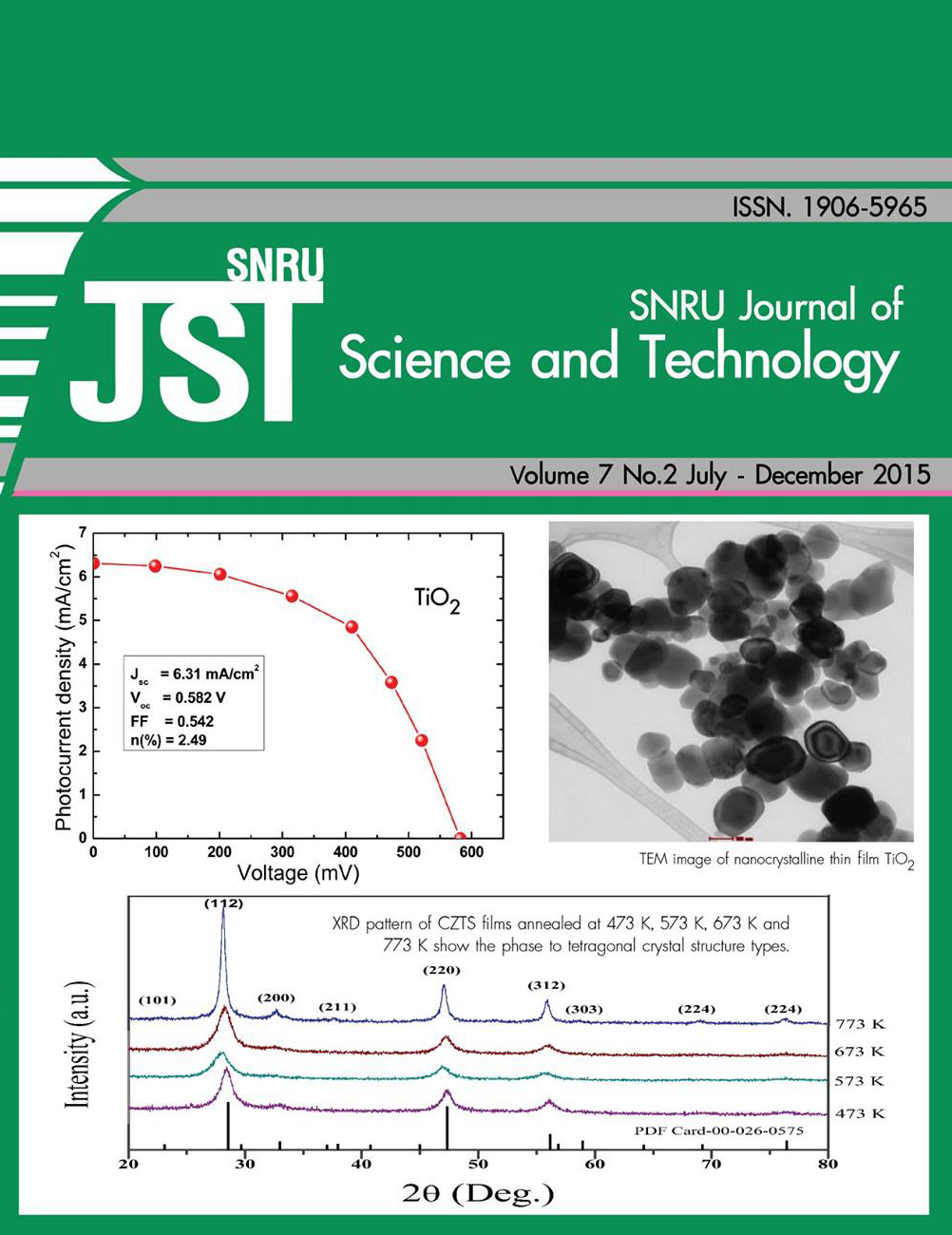สูตรลูกประคบสมุนไพร ลดอาการปวดคัดตึงเต้านมของมารดาหลังคลอด Herbal formulas developed to reduce maternal postpartum breast engorgement
Keywords:
ลูกประคบสมุนไพรสูตรดั้งเดิม, ลูกประคบสมุนไพรสูตรพัฒนา, การประคบสมุนไพร, การคัดตึงเต้านม, มารดาหลังคลอดAbstract
การพัฒนาสูตรลูกประคบสมุนไพรครั้งนี้ มีวัตถุประสงค์ เพื่อศึกษาผลลดอาการปวดคัดตึงเต้านมและเพิ่มอัตราการไหลของน้ำนมของมารดาหลังคลอด โรงพยาบาลพังโคน อำเภอพังโคน จังหวัดสกลนคร เป็นการวิจัยเชิงทดลอง เปรียบเทียบก่อนและหลังการประคบด้วยลูกประคบสมุนไพรสูตรดั้งเดิมและสูตรที่พัฒนา โดยทำการศึกษาในหญิงหลังคลอดที่มีอาการคัดตึงเต้านม โดยใช้กลุ่มตัวอย่างจำนวน 30 คน เครื่องมือที่ใช้ในการวิจัยคือ แบบสอบถามที่ผู้วิจัยสร้างขึ้น มี 4 ขั้นตอน และทำการวิเคราะห์ข้อมูลด้วยคอมพิวเตอร์โดยใช้โปรแกรมสำเร็จรูป หาค่าเฉลี่ย ร้อยละ ความถี่ และส่วนเบี่ยงเบนมาตรฐานและการทดสอบทางสมมติฐานใช้ค่า Paired t-test การศึกษาระดับความปวดคัดตึงเต้านมของมารดาหลังคลอดก่อนและหลังการประคบเต้านมด้วยลูกประคบสมุนไพรสูตรดั้งเดิมและสูตรที่พัฒนา จากกลุ่มตัวอย่างก่อนทำการประคบสมุนไพรสูตรดั้งเดิม วันที่ 1 และวันที่ 2 มีค่าเฉลี่ย 5.2 และ 3.47 ตามลำดับ และระดับความปวดคัดตึงเต้านมก่อนทำการประคบสมุนไพรสูตรพัฒนา วันที่ 1 และวันที่ 2 มีค่าเฉลี่ย 5.53 และ 3.73 ตามลำดับ และหลังจากทำการประคบสมุนไพรสูตรดั้งเดิม วันที่ 1 และวันที่ 2 พบว่า กลุ่มตัวอย่างมีระดับความปวดลดลงเฉลี่ยที่ 3.27 และ 1.40 ตามลำดับ และหลังจากทำการประคบ สมุนไพรสูตรที่พัฒนา วันที่ 1 และวันที่ 2 พบว่า กลุ่มตัวอย่างมีระดับความปวดลดลงเฉลี่ยที่ 2.93 และ 1.20 ตามลำดับ การศึกษาอัตราการไหลของน้ำนมก่อนการประคบสมุนไพรสูตรดั้งเดิม วันที่ 1 และวันที่ 2 เฉลี่ยที่ 2.07 และ 2.53 ตามลำดับ อัตราการไหลของน้ำนมหลังการประคบสมุนไพรสูตรดั้งเดิม ครั้งที่ 1 และ 2 เพิ่มขึ้นเฉลี่ยที่ 2.40 และ2.87 ตามลำดับ และอัตราการไหลของน้ำนมก่อนการประคบสมุนไพรสูตรพัฒนา วันที่ 1 และวันที่ 2 เฉลี่ยที่ 2.00 และ 2.93 ตามลำดับ และอัตราการไหลของน้ำนมหลังการประคบสมุนไพรสูตรพัฒนา วันที่ 1 และวันที่ 2 เพิ่มขึ้นเฉลี่ยที่ 2.87 และ 2.73 สรุปว่าลูกประคบสมุนไพรสูตรที่พัฒนาสามารถลดอาการปวดคัดตึงเต้านมและเพิ่มอัตราการไหลของน้ำนมได้ดีกว่าลูกประคบสมุนไพรสูตรดั้งเดิม และมีความแตกต่างกัน อย่างมีระดับนัยสำคัญทางสถิติ (p<0.05)
The development of this herbal formulation aims to reduce engorgement pain associated with flow rates of the breast milk of mothers after birth at Sakon Nakhon Hospital. The experimental research was compared before and after the massage with herbal compress original recipes and recipe development. The study in postpartum women with symptoms of breast engorgement used a sample of 30 people. The instruments used in the study were: questionnaires, the researcher create a stage 4 and then analyzed by software, percent, average, frequency, and standard deviation and tested hypotheses using the Paired t-test. Educational level of the mother's pain, breast tenderness before and after the compression postpartum breast with herbs, traditional formula, and recipe development of samples prior herbal original formula of day 1 and day 2 were at a mean score of 5.2 and 3.47, respectively. Breast tenderness and pain herbal formula before day 1 and day 2, were averaged of 5.53 and 3.73, respectively. Herbal and traditional recipes after day 1 and day 2 showed that the samples had an average rate of pain reduction of 3.27 and 1.40, respectively. Herbal formula developed after day 1 and day 2 showed that the samples had an average pain reduction at 2.93 and 1.20, respectively. The study of the flow of breast milk before herbal original formula of day 1 and day 2 averaged at 2.07 and 2.53, respectively. The rate of breast milk flow after herbal original formula No. 1 and 2 had an average rate of increase to 2.40 and 2.87, respectively. The rate of flow of breast milk before formula herbal day 1 and day 2 were averaged at 2.00 and 2.93, respectively. The flow rate of herbal formula milk after day 1 and day 2 showed an average increase at 2.87 and 2.73. It was concluded that the herbal formula developed tended to reduce pain, increase breast tenderness and milk flow, which were better than traditional herbal formulas with a statistical significance of p<0.05.









